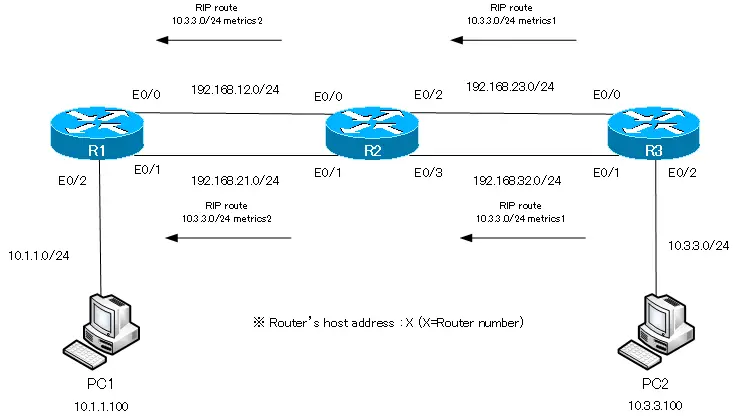Table of Contents
What is “Equal Cost Multi Path Load Balancing” ?
As a general rule, only the best route information for a given network is registered in the routing table. If there are multiple routes that can be considered as the best, routing load balancing can be performed. The case of multiple best routes is when there is more than one route information that minimizes the metric. This type of routing load balancing is called equal-cost multi path load balancing.
EIGRP also allows load balancing on multiple routes that do not have the same metric. Load balancing on routes that do not have the same metric is called unequal cost multi path load balancing.
Example of Equal Cost Multi Path load balancing (RIP)
The following is an example of equal-cost multi path load balancing.

We will focus on the route information for the network 10.3.3.0/24 on R1. In this example, we are using RIP as the routing protocol, and there are two lines between R1 and R2, and two lines between R2 and R3.
Route information of 10.3.3.0/24 from R3 is sent from each line to R2. Its metric is 1. Then, R2 further sends the route information of 10.3.3.0/24 to R1 with metric 2.
R1 is receiving two routes with the same metric as the route information for 10.3.3.0/24. With equal-cost multi path load balancing, both are considered to be the best route with the least metric route information, and both are registered in the routing table.When routing packets from R1 to 10.3.3.0/24, distribute them to the next hops 192.168.12.2 and 192.168.21.2.
The routing table on R1 will look like the following
R1
R1#show ip route rip
10.0.0.0/24 is subnetted, 2 subnets
R 10.3.3.0 [120/2] via 192.168.21.2, 00:00:17, Ethernet0/1
[120/2] via 192.168.12.2, 00:00:24, Ethernet0/0
R 192.168.23.0/24 [120/1] via 192.168.21.2, 00:00:17, Ethernet0/1
[120/1] via 192.168.12.2, 00:00:24, Ethernet0/0
R 192.168.32.0/24 [120/1] via 192.168.21.2, 00:00:17, Ethernet0/1
[120/1] via 192.168.12.2, 00:00:24, Ethernet0/0
The maximum number of routes that can be registered for equal-cost multi path load balancing is 4 by default. The maximum value can be further changed in the settings.
Also, although we are considering RIP as an example, the same applies to OSPF and EIGRP. Furthermore, equal-cost multi path load balancing is possible not only with routing protocol route information but also with static routes. By configuring multiple static routes for the same network address, equal-cost multi path load balancing with static routes is possible.
Summary
Summary
- Equal-cost load balancing is to register multiple route information in the routing table to perform load balancing when there are multiple route information that can be considered best with minimum metric (cost).
- In EIGRP, not only equal-cost but also unequal-cost multi path load balancing is possible.
- Equal-cost multi path load balancing is possible not only with route information from routing protocols such as RIP and OSPF, but also with route information configured with static routes.
IP Routing Basic
- Router – The central device that performs routing
- Dividing Network with router
- Layer3 Switch Overview
- Measuring the distance to the destination network -Administrative Distance and Metric
- Equal Cost Multi Path Load Balancing
- Cisco Static Route Configuration
- Example of Cisco Static Route Configuration Step by Step
- RIP Split horizon
- RIP Timers
- RIP Route Poisoning – Quickly remove unnecessary route information
- Cisco RIP Basic Configuration and Verification Commands
- Cisco RIP Configuration Example
- Generating a default route in RIP – Redistribution of static route
- Passive-Interface ~Stops Routing Protocols from Sending Packets
- Default Gateway Redundancy Overview
- How the Cisco HSRP works
- Configuring and Verifying Cisco HSRP
- How VRRP works
- Configuring and Verifying commands for VRRP [Cisco]
